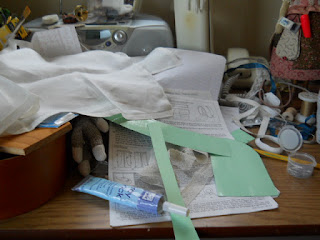Hello Dollmakers! This morning, while I was having my coffee, I think I heard a collective sigh of relief from all those parents whose children have gone back to school today. In celebration, I started two black versions of Gail Wilson's Hitty doll. To see more of this Hitty and all her accoutrements, please visit Gail's website:
http://www.gailwilsondesigns.com/catalog/hitty.html
Before I begin painting, I always clean up my work table so the mess doesn't migrate to other things setting nearby. I put down a clean sheet of freezer paper to protect the table and figure out where you will put the wet paint items to dry. I learned the hard way that this is an important step - and to do it ahead of when you start painting so that you are not looking for somewhere to hang the wet part while you are holding it. It's even harder to set up a spot while you are holding the wet piece. So lesson learned, I get it ready ahead of time. I have a nice block of styrofoam and some tooth picks waiting nearby. I also get out my good light and some reader glasses to magnify what I am seeing. All these items are like "insurance" - to help me do a good job.
Gail has nice skin colors of paint, and since I have Etsy folks asking for black Hitties, black skin paint it is. I have a nice newer-ish larger paint brush and some rags and water all set (keep the paint covered until you start to paint as it dries out).
First and formost, we take a good look at the paper mache heads and limbs and fix any blemishes that need fixing. The ones I have here are pretty clean and only a few finger prints need to be wiped away. I do this by wetting a 6x6" square of t-shirt with water and rubbing the part. If there are things that need fixing, you can use paperclay, a bit of flumo dripped over the flaw, or wood filler. Sand paper can be used to sand away any extra mold marks that bother you.
Once they are wiped, they dry pretty fast and I can apply the skin paint. Keeping your brush clean, work your way around the head going into the hair area. Should I paint in the holes or not? The instructions in the Hitty kit are wonderful; no questions as to where to paint. There are tips to help you do a great job. I don't feel I have any special gifts in the doll making arena, I'm just a regular Jane, but when I follow Gail's instructions, I always end up with an heirloom quality doll. Once you have gone around once with one coat, check for any missed spots which will show up white. If you see very thin "see thru" areas, you can paint over them once you have gone around once. After you think you are finished, do a final check to ensure you got every where with your first coat. Don't worry too much if it isn't perfectly even, it will be after the second coat is applied.
Here is the first coat applied to the heads including where the hair will get painted black later. One thing to mention - weight distribution is important. You don't want your block to tip over with one wet head on it, so be sure to place your heads in a spot that will not cause the block to tip. Or if it is hollow underneath, you can place the styrofoam over a heavy object that will hold it in place.
 |
| Add caption |

After these are good and dry, they will get a second coat. I like to pull off all the parts from the styrofoam block so I don't knock into the other pieces when I try and put the wet parts back on the foam. It also helps you know what piece is painted again so you don't miss any.
After the second coat dries, I switch over to alkyd oil paints because it is easier for me to get a good result with them. I struggle with acrylics because they dry so fast and I am not an expert painter. Oil paints take longer to dry which means I have longer to fix my boo-boos. Alkyd oils take less time than regular oils, so they are a good fit for me.
Put away all the water based paint things so you don't get confused and use water instead of turpintine. (yeah, it happens, so this is why I take the steps to insure I get it right).
And you need some ventilation for oil paints, so the fan comes out and a window gets opened even though the a/c is on. Just a couple of inches at the top to pull out the fumes. I use such small amounts of paint and turp, the fumes are hardly noticable, but I like to follow the safety rules.

I also like to have a couple of different brushes: a fine 18/0 spotter for going around the edges of the hairline and for the face details, a small filbert 20/0 for an eraser brush, and a #2 filbert for filling in the hair. In addition, I have a small palette, a small stack of 6x6" rag squares for cleaning my brushes while I am painting and a small jar for a teaspoon of turpinoid. Yes, that is all the turpinoid I need because I clean off my brushes by swiping them on a rag until all the paint comes off and then I dip into the turp and swipe again on the rag. No swishing a very dirty brush in the turp....it just makes a bigger mess. Keep the paint on the rags, using the turp only when you can't get any more paint off the brush onto the rags. Also dip just the tip of the brush in the turp and it will suck up some turp without getting paint into the jar of turp.
If you would like to have a good set of instructions of working with oil paints for dolls, Gail's Emma and Charlotte doll kits or patterns are an excellent choice. These dolls are painted with alkyd oils and the instructions cover what colors you will need for doll faces, how to mix the skin and other colors, how to shade faces for depth, brush care, and much more. I made the jump to oils several years ago and still love the way I can get a super doll face with less struggle.
I paint the hair with ivory black paint starting with the outline of the hair using the 18/0 spotter. Just a small amount of paint is all you need. Keep your brush clean clean clean, and it will perform better. When you feel the paint is not flowing off your brush as well, then time to clean it by swiping it on the rags and then getting some turp and swiping again. A clean brush is your friend when it comes to painting small. Also, use very little paint on the very tip of the brush. Oil paint is easy to slide around - oh so much easier than acrylic.
If you go a bit outside the mold mark for the hair, take your 20/0 filbert, dip it in the turpinoid and dry it off as well as you can by squeezing it inside a small rag. Then use this brush to PUSH the stray paint back into the outline. Wipe the brush clean and push some more if you need to. Always clean your eraser brush before you put it down. Then if you push too far into the outline, you can always take your paint brush (put the eraser brush down, and use it only for erasing) and add more paint in again. I try and keep the hair paint just a hair (pun intented) inside the hair line. Sometimes it's easier to hold the head upside down to get a good angle.
It's important that you check yourself now and then for paint on your fingers so you don't get it onto her face or neck area. I keep a rag with some turp on it for just in case I get it on me and I can wipe it off easy without gettting it on other things.
For the back, where there isn't a mold line to follow, the #2 filbert brush comes in handy
for the scallops. The natural shape of the filbert is the perfect shape for the scallop hairline. Or you can just free hand paint in the scallops with the 18/2 spotter brush.
Once the outline is complete, you can use any larger brush and paint in the rest of the hair. If you wish, use the tiny spotter, very cleaned of paint and just a touch of turp wiped off, and pull off paint at the center top of her head for a 1/4" or less to make it look like a part.
When you are all finished, do a check to ensure you don't have any unpainted areas. Here they are all skin and first coat of hair painted. Now they are ready to be "put up" out of danger of getting bumped.
Here's a good spot, up on a shelf with all the UFO dolls.....no body is going over there for awhile. Oh, the Joel Ellis is just getting a spot of repair done, she doesn't really belong with the UFO's either.
While these dry for a few days (the downside to oils is that they take time to dry - regular oils take a week, alkyd oils dry to a tacky feel in 24 hours and well enough to paint eye whites in 2 days) we'll sew the bodies.
I hope you had doll fun today and thanks for visiting - Julie
PS - Gail has a new face painting service available, so for those of you who want one can get a painted face in your doll kits.














































